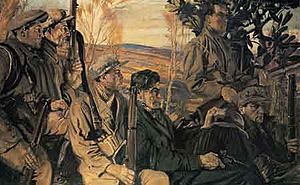Seán Keating facts for kids
Quick facts for kids
Seán Keating
|
|
|---|---|

Self-portrait in the Hunt Museum
|
|
| Born |
John Keating
28 October 1889 County Limerick, Ireland
|
| Died | 21 December 1977 (aged 88) Dublin, Ireland
|
| Education |
|
| Known for | Irish romantic-realist painter |
|
Notable work
|
Men of the South, Irish Gothic, An Allegory, Night's Candles Are Burnt Out, Race of the Gael |
Seán Keating (born John Keating, 28 September 1889 – 21 December 1977) was a famous Irish painter. He painted in a style called romantic-realism. This means his art showed real life but often with a heroic or emotional feeling. He created many well-known pictures about Ireland's fight for independence and its early industrial growth. Keating also loved painting the people of the Aran Islands, showing them as strong and brave.
Contents
Seán Keating: An Irish Artist
Early Life and Training
Seán Keating was born in County Limerick, Ireland. He started learning to draw at the Limerick Technical School. When he was 20, he received a special scholarship. This allowed him to study art at the Metropolitan School of Art in Dublin. A famous artist named William Orpen helped him get this chance. For several years, Keating spent time on the beautiful Aran Islands, which later inspired many of his paintings.
Painting Ireland's History
After his studies, Keating returned to Ireland. He began to paint important moments from the Irish War of Independence and the Irish Civil War. These wars were a big part of Ireland's history.
One of his famous works is Men of the South (1921–22). It shows a group of IRA men ready for action. Another key painting is An Allegory (1924). This artwork shows the two sides of the Civil War burying a coffin. The coffin is covered with the Irish flag. Keating even included himself in this painting.

Art and Industry
In 1918, Keating became an Associate of the Royal Hibernian Academy (RHA). He became a full member in 1923. In the 1920s, Ireland built a huge power station. It used water to create electricity at a place called Ardnacrusha.
Between 1926 and 1927, Keating decided to paint this amazing project. He created many artworks showing the workers and the machinery. These paintings captured the spirit of a new, modern Ireland. Many of these works are now owned by the ESB Group, Ireland's electricity company.
His Legacy
Keating was the President of the Royal Hibernian Academy from 1950 to 1962. He showed his art at their yearly exhibition for 61 years! He was an artist who thought deeply about Ireland's identity. His paintings often showed an idealised, or perfect, view of Irish life. He worried that new art styles might lower artistic standards.
Keating married May Walsh in 1919. She was a political activist and often posed for his paintings. Seán Keating passed away on 21 December 1977. His art continues to be an important record of Irish history and culture.
Work in Collections
Seán Keating's paintings can be found in many important art collections:
- The Electrical Supply Board in Ireland
- The National Gallery of Ireland, Dublin, including An Allegory
- Crawford Municipal Art Gallery, Cork, including Men of the South
- Trinity College Dublin, including a portrait of Erwin Schrödinger
- Limerick City Gallery of Art, Limerick, including The Kelp Burners and a self-portrait
- Centre William Rappard in Geneva, Switzerland, which has his Mural on Labour
Images for kids







